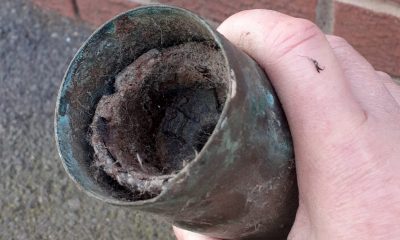By Mark Waghorn via SWNS
A daisy lures pollinators by mimicking female insects, new research reveals.
The South African species Gorteria diffusa has evolved a sexually deceptive floral strategy unique to nature, say scientists.
It builds a complicated structure on its petals resembling a prospective mate - complete with bumps and white highlights.
The male approaches and lands on top for what he expects will be a bit of hanky panky - jiggling around.
He makes a series of attempts before finally realizing things aren't turning out quite as he hoped.
Eventually, he gives up and buzzes off, unsuccessful. The plant, meanwhile, has got what it wanted - pollen.
Now scientists have uncovered the secret to the extraordinarily convincing three-dimensional deception. It has intrigued biologists for decades.
The Cambridge team identified key genes involved in the scam. Remarkably, they already have other functions.
One moves iron around, another makes root hairs grow and the third controls when flowers are made.
The study found they all combine - to build fake lady flies.
via GIPHY
The "iron moving" genes add iron to the petal's normally reddish-purple pigments, changing the color to a more fly-like blue-green.
The root hair genes make hairs expand on the petal to give texture. The other group make the fake flies appear in apparently random positions.
Senior author Professor Beverley Glover, from the University's Botanic Garden, said: "This daisy didn't evolve a new "make a fly" gene. Instead it did something even cleverer.
"It brought together existing genes, which already do other things in different parts of the plant, to make a complicated spot on the petals that deceives male flies."
The daisy’s petals give it an evolutionary advantage - by attracting more male flies to pollinate it, say the researchers.
The plants grow in a harsh desert environment, with only a short rainy season in which to produce flowers, get pollinated, and set seeds before they die.
This creates intense competition to attract pollinators - and the petals with fake lady flies make the South African daisy stand out from the crowd.
Compared to most living organisms, the sexually deceptive daisy belongs to a group of plants only 1.5 to two million years old - very young in evolutionary terms.
The earliest members of this family tree didn't have the fake fly spots, which means they must have appeared on the daisy petals very rapidly.
First author Dr. Roman Kellenberger said: "We would expect something as complex as a fake fly would take a long time to evolve, involving lots of genes and lots of mutations.
"But actually, by bringing together three existing sets of genes it has happened much more quickly."
To carry out the study, the researchers compared which genes were switched on in daisy plant petals - with and without fake flies.
They also looked at petals from a different type of daisy that produces a simple spot pattern, to work out which genes were specifically involved in making the daisy's spots so deceptive.
Gorteria diffusa is the only example of a flower that produces multiple fake flies on top of its petals.
Other members of the daisy family make much simpler spots – for example spots in a ring around all the petals - that aren’t very convincing to real flies.
By comparing the different daisies in the family tree, the researchers were able to work out the order that the fake flies came into being: color first, then random positioning, then texture.
Kellenberger added: "It is almost like evolving a whole new organ in a very short time-frame. Male flies don't stay long on flowers with simple spots.
"But they are so convinced by these fake flies that they spend extra time trying to mate, and rub off more pollen onto the flower - helping to pollinate it."
The study is in Current Biology.

 Parenting2 days ago
Parenting2 days ago
 Broadcast4 days ago
Broadcast4 days ago
 Broadcast3 days ago
Broadcast3 days ago
 Broadcast1 week ago
Broadcast1 week ago
 Funny1 week ago
Funny1 week ago
 Shopping1 week ago
Shopping1 week ago
 Money4 days ago
Money4 days ago
 Parenting1 week ago
Parenting1 week ago






















